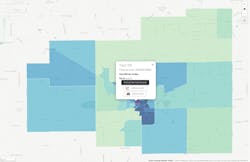Last year Healthcare Innovation spoke with Terry Scoggin, CEO of Titus Regional Medical Center in Mt. Pleasant, Texas, about using data analysis and visualization tools to highlight health disparities in rural Texas communities. In Ohio, stakeholders, including local hospitals, the public health department, and the United Way used the same tools to create the Allen County Health Atlas.
“Activate Allen County” came to life in 2012 when a group of area leaders created a public health initiative committed to improving the health of all Allen County residents. The collaboration began with Centers for Disease Control grants but is now fully funded locally. The collaboration took on a new direction in 2022 as it began to better leverage hyper-local data with the launch of the Allen County Health Atlas, leveraging software from Metopio.
The Allen County Health Atlas, supported by partners like Mercy Health, the Allen County Public Health Department, the county mental health board, the City of Lima and nonprofits like the United Way and the local chamber of commerce, gives the public, community-based organizations, businesses and researchers access to data across Allen County’s 12 cities and towns, 19 ZIP codes, and 35 Census tracts.
“We’ve had this collaboration working for many years prior to the creation of the Health Atlas,” said Kayla Monfort, co-director of Activate Allen County. “Many times we were frustrated with our community health assessments and the tools we had at our disposal prior to the partnership with Metopio. It was just a challenging battle for us, because we didn't think we were seeing all the data we wanted to see and how to compile that. We’re not data scientists. We don't have a lot of extra time, being a staff of two co-directors. But the data is such an important factor in how we do our work.”
“We wanted to leverage the Health Atlas to make data more accessible for a lot of nonprofits,” explained Tyler Smith, director of Community Health-Lima at Bon Secours Mercy Health in Lima, Ohio. “They may be submitting requests for funding through United Way or through ourselves or other large players in the community. It allows all different sectors — healthcare, government, and nonprofit — to move together, because it really does require everybody to have a seat at the table to reach some of the goals that we have in terms of outcomes.”
Smith chairs the Community Investment Committee at the hospital. He said the data they had been looking at was very skewed toward the ZIP code level. “Using the Health Atlas and Metopio allowed us to get to more of a granular level, and understand data and populations from Census tracts and neighborhoods,” he said. “That got us into the conversation to say just around the hospital campus here in Lima we can have a huge impact. And that's why the partnership with Activate is so crucial because we can move together and partner on some of these initiatives.”
The Activate Allen County team has leveraged data from the Allen County Health Atlas to help secure a grant that is geared toward Health Improvement Zones. “That’s been a huge part of our work with the place-based funding,” Monfort said. “Instead of corporations and hospitals spreading out their dollars throughout the community to see improvement, this involves really diving in and putting more dollars in one or two neighborhoods to see that area improve. We have three Census tracts where we really want to see marked improvement. We recently hired some community health workers, who are putting the time and energy to making sure that these folks are really taken care of and have a place in our community and feel like their needs are being met.”
Angela Grover, Metopio’s co-founder and COO, says this is about data equity. “The data exists, and typically you have to have data scientists to get access to it, to crunch it from all of these different places. And to Tyler's point, it's not only granular data, but multivariable data. If you're looking at housing, you look at the cost of housing or the availability of housing, the quality of housing."
Having all of those different community factors, in addition to health outcomes, paints a clear picture for the intersection of the social determinants of health and the health outcomes, Grover said. “Community-based organizations don't have data scientists. They know what's happening in their community, but in order to write a grant, you need some data. And so the Atlas gives them that access to data. None of us are going to solve the social determinants of health by ourselves, but together through somebody like Activate, we can all focus where we need to, and have other people bringing resources to the table to do their part of it. An Atlas really opens the data up. It makes for an equitable conversation. Everybody's got access to it, so they can raise whatever concerns they want. They can take their lived experience and look at the data and raise something that they think needs to be addressed.”


